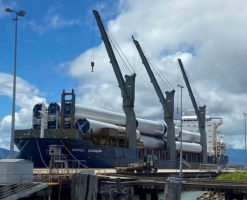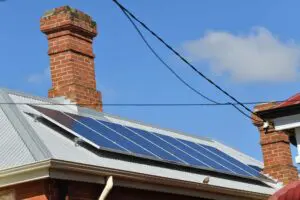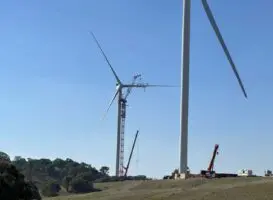The Climate Council says Australia could undergo a ‘new industrial revolution’ if it seizes on the global transition to renewables, and manufactures critical metals and other clean industry materials onshore.
But the Council says doing so will require serious policy change, according to its new report, Australia’s Clean Industry Future: Making Things Here in a Net Zero World.
In the report, Climate Council points out that Australia has abundant natural resources that could make it an industry leader in the transition to a net zero world – that includes massive underground deposits of minerals needed in clean energy technology, as well as enough sunlight to theoretically power the nation 100,000 times over.
To get there, Australia would need to clean up its key manufacturing industries, including steel, aluminium and ammonia production.
Opportunities for cleaner industry
Steel, for example, is a deeply polluting industry. Almost two tonnes of CO2 are emitted for every tonne of steel produced, on average, accounting for about 7% of global greenhouse gas emissions. Steelmaking require stripping oxygen from iron ore to produce pure iron, and it’s usually done by burning large amounts of coal or natural gas.
Australia produces approximately 3.5 million tonnes of steel annually, according to the Australian Steel Institute, employing about 110,000 Australians. But that industry is dwarfed by the gargantuan export of iron ore, the raw material from which steel is made, to global markets, amounting to an estimated 896 million tonnes in the financial year 2022-23.
The report concludes that if Australia made green steel onshore by refining its own iron ore using renewable hydrogen as a reductant – rather than shipping the bulk of its iron ore overseas – that shift alone would avoid 1.5 billion tonnes of GHG emissions annually, equivalent to three times the amount Australia emits each year, and would generate ten times the profits the iron ore industry does today.
According to the report, such a move is not beyond the realm of possibility: in Sweden, where only 86 million tonnes of iron ore are produced per year as compared with the 922 million tonnes that were mine in Australia in 2020-21, trials to fully decarbonise steel are underway with plans to shift to full commercial production within five years.
But the road won’t be without its bumps: iron ores from the Pilbara, one of the biggest suppliers of the stuff, are peppered with impurities such as silica, alumina and phosphorus, which are intolerable to electric arc furnaces – the current best method for producing steel using hydrogen. Steelmakers will be forced to find better options if they hope to keep up with demand for low-carbon steel.
Another industry seen as a potential green energy heavyweight is aluminium. Australia is the world’s largest producer of the aluminium ore bauxite: in 2021, Australian mines produced 101 million tonnes of bauxite, with 39 million of those exported overseas and the remainder converted to alumina – the material from which aluminium is smelted – in Australia.
Aluminium is another polluting sector: the energy intensive metal generates around 2% of global human-caused emissions, according to the World Economic Forum, with alumina refining and aluminium smelting responsible for over 90% of the sector’s direct CO2 emissions, according to the International Energy Agency(IEA). But aluminium is also needed to make many of the technologies required in the race to net zero.
Steps are already being taken to decarbonise the sector: in 2021, Rio Tinto announced plans to conduct a $1.2 million feasibility study, part funded by ARENA, to investigate using clean hydrogen to replace natural gas in the calcination process of alumina refining at its Yarwun refinery in Gladstone, Queensland (calcination accounts for approximately 30% of alumina refinery emissions, according to ARENA).
The report of that initial feasibility study, published in late 2022, found that hydrogen was a suitable substitute for natural gas under the conditions require for alumina calcination. The project itself is still ongoing, with more research underway aiming for a full-scale industrial demonstration of a hydrogen-powered calciner.
And New South Wales’ largest energy user, Tomago Aluminium Company (TAC), is already planning to operate exclusively on renewable energy by 2030. That’s major, given the company’s smelter uses the same amount of energy as approximately 56,000 households.
The report says Australia should position itself as a world leader in green aluminium production, fuelled by the country’s abundant renewable energy, through government support for the industry’s complicated transition.
Other sectors the report says could be decarbonised to become global export heavyweights include green-ammonia based fertilisers and renewable hydrogen. So, what’s stopping us?
Make a change or risk being left behind
The report cautions that Australia’s biggest industrial emitters will need to cut their pollution and radically change their practices to stay globally competitive, or be left behind in a net zero world. The only way to make that happen, according to Climate Council, is through policy change.
Moves from global powers are reinforcing that point: in August last year US President Joe Biden signed the Inflation Reduction Act, a bill that will invest $369 billion in climate solutions that aims to get the US to 40% emissions reductions by 2030.
That bill includes a $60 billion investment in the manufacturing of solar panels, batteries and other clean energy technologies in the US.
Last month, the Clean Energy Council warned that the new Act, while a boon for climate action, would endanger Australia’s hopes of becoming a “clean energy superpower”, as green investors and skilled workers turn to the US.
“It is immediately clear the US package dwarfs the level of support Australian governments provide for the clean energy transition,” said Clean Energy Council Chief Executive Kane Thornton at the time. “The consequences of inaction have the potential to damage Australian competitiveness across all industries for decades to come.”
On the flip side, the move, alongside a broader global shift towards clean energy, means demand for critical minerals will continue to soar, presenting Australia with what Climate Council sees as a golden opportunity.
“A new global Industrial Revolution is underway as the world aims to get to net zero emissions and limit dangerous global warming, and this is shifting investment away from polluting industries towards clean ones,” says Nicki Hutley, Climate Councillor and independent economist.
“To stay competitive in this net zero world, Australia’s heavy industries – including steelmaking, aluminium and metal production, cement, and chemical production – will need to undergo a big transformation, but the good news is that we have the resources and know-how to do this.”
The best vehicle for ensuring a swift and just transition, according to Climate Council, is the ongoing reform of the Safeguard Mechanism.
The Safeguard Mechanism regulates carbon pollution from Australia’s 215 biggest industrial emitters, requiring that they emit below a baseline or offset excess emissions by purchasing Australian Carbon Credit Units (ACCUs). The Department of Climate Change, Energy, Environment and Water (DCCEEW) is consulting on options to reform the Safeguard Mechanism to help industry reduce its emissions in line with Australia’s climate targets – considered to be one of the Labor Government’s biggest climate policy opportunities.
As part of the reforms, the Federal Government has proposed gradually reducing baselines to help Australia reach net zero by 2050, introducing credits for facilities that emit less than their baseline, and providing tailored treatment to “emissions-intensive, trade-exposed” facilities so they’re not disadvantaged compared to their international competitors. The Government hopes to initiate these reforms as early as July this year.
But Climate Council wants to see further adjustments to the reforms, including prioritising crucial domestic industries that have a long-term future in a net zero world, direct government support to sectors like steel, aluminium, cement and chemicals so they can undertake technology trials and update their facilities, and requiring the largest emitters – particularly fossil fuel producers – to deliver genuine emissions reductions rather than perennially offsetting.
“The Federal Government’s reform of the Safeguard Mechanism is a critical opportunity to deliver the right policy settings to help future-proof industries, protect Australian manufacturing, and reduce harmful carbon pollution,” says Climate Council CEO Amanda McKenzie.
“If we get the Safeguard Mechanism right, this will drive green manufacturing and more great jobs to power the next era of Australian prosperity.”










